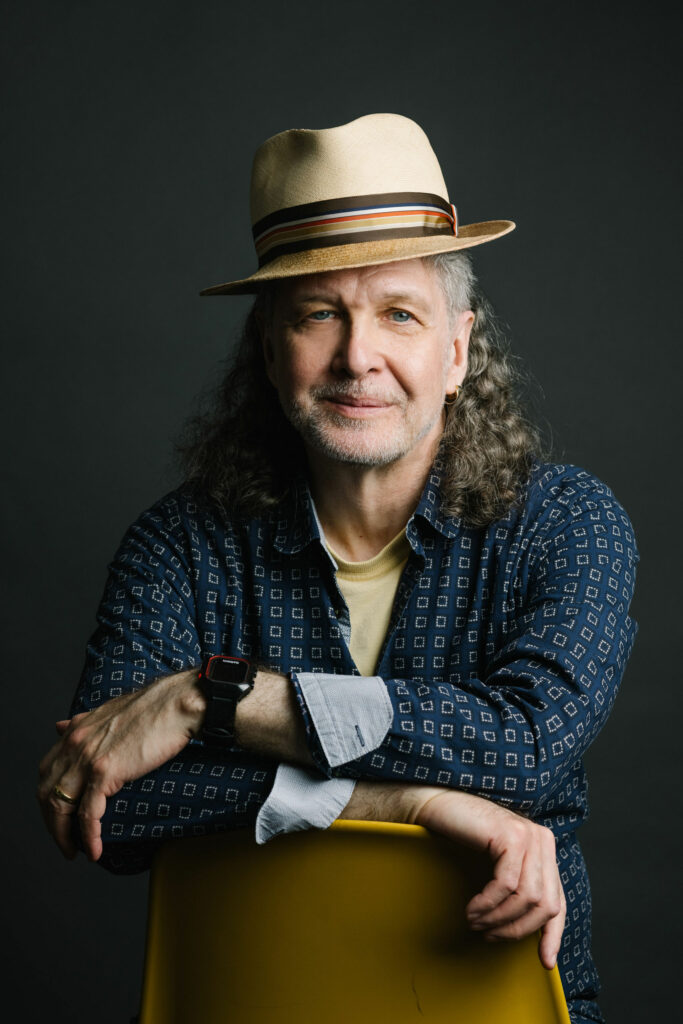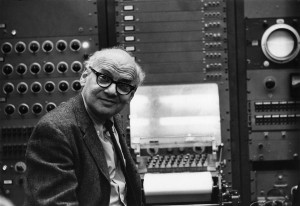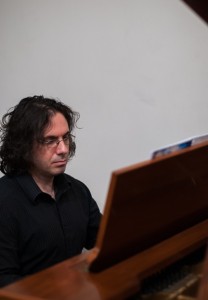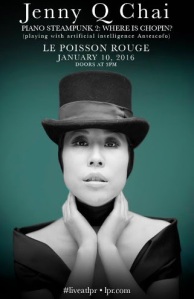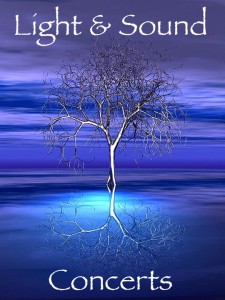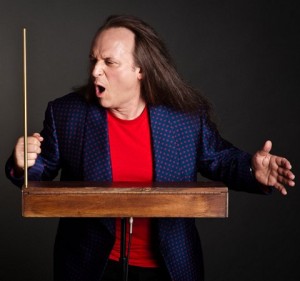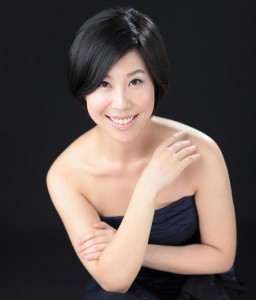d
I first met Hayes Biggs in Venezuela in the 1990s, at a contemporary music festival in Caracas. We bonded over a street artist’s unique t-shirt designs, and over the performances by musicians from all corners of the Americas.
Since then, Biggs has been a regular fixture at new music concerts in New York City, as well as on stage with C4, the Choral Composer/Conductor Collective ensemble. He has been on the faculty of Manhattan School of Music teaching theory and composition since 1992. On May 31, 2023, four long-time champions of contemporary chamber music – violinist Curtis Macomber, violist Lois Martin, cellist Chris Gross, and pianist Christopher Oldfather – perform Biggs’ works in recital in a composer portrait at Merkin Hall in New York City.
In advance of the concert, I asked Biggs about the evolution of his compositional style and his career path. Here is our interview.
Gail Wein: In addition to your work as a composer and as a teacher at MSM you are also a choral singer. How does that experience inform your instrumental compositions?
Hayes Biggs: I strive to write beautiful melodic lines, harmonies and counterpoint. Studying voice as a college student, singing in choirs, and accompanying singers and choral groups has had a profound effect on all the music I write, in whatever medium or genre. More than once it has happened that bits of my vocal music (and occasionally that of others) have found their way into my instrumental works. For example, my String Quartet: O Sapientia/Steal Away (2004) is based to a great extent on two such pieces: a choral motet for Advent that I wrote in 1995, and the African American spiritual Steal Away. I had sung the latter in my college choir in William Dawson’s magnificent arrangement as a freshman in college, and that version was the inspiration for the last movement of the quartet.
GW: The piano preludes on your May 31 program are inspired by poetry. How do these preludes reflect the poems?
HB: Only the first three of the preludes (commissioned by Thomas Stumpf) have specific connections to poems, and I would see them as suggestive of certain general moods rather than as attempting to depict literally any events or images contained in the poetry. In No. 1, “The Secret that silent Lazarus would not reveal,” on Billy Collins’s “The Afterlife,” where the poet imagines the dead all going wherever they imagined they would go after death, I had the idea of a kind of jazzy march, tinged a bit with blues and gospel, as they all parade off in their separate directions. The second, on Wendell Berry’s “The Peace of Wild Things,” seems to me to move from a mood of sadness and anxiety to one of serenity. The third prelude, on one of Rilke’s Annunciation poems from Das Marienleben, is dedicated to the memory of my mother-in-law Lois Orzel, and is intended to convey the quiet strength of the Virgin Mary and the awe in which the powerful angel Gabriel regards her. The fourth prelude is simply a short, playful study in rhythm, with bright major triads and crisply articulated eighth notes in shifting meters alternating with a heavier, bluesier, swinging triplet feel. It is dedicated to my friends David Rakowski and Beth Wiemann.
GW: The selections on the May 31 program are all fairly recent works. Tell me about your compositional style and approach, and how it has changed over the years (or not).
HB: I’m as eclectic as they come, kind of a musical omnivore. I tend to view stylistic purity as highly overrated. As far as my love of classical music is concerned, I think that initially I was knocked sideways by Beethoven, Bach, and Mozart, and then became enthralled by Chopin, Brahms, Schumann, Wagner, and later, Richard Strauss. I fell in love with harmony, the richer the better.
The first modern music I responded to was in an American idiom inspired by Stravinskian neoclassicism and Hindemith, including Persichetti, Bernstein, Copland, William Schuman, and others. I later discovered the Second Viennese School and the late works of Stravinsky. Two favorite composers of mine, Alban Berg and Stravinsky, both exemplify something that has preoccupied me for years: the reconciliation of tonal and non-tonal elements in the same work. Being diametrically opposed in their respective aesthetics, they approach this reconciliation in very different ways. Berg goes for a seamless fusion of atonal elements with Romantic gestures and tonal-sounding harmonies, in a language that evokes Mahler, while Stravinsky in a work like Agon, seems to embrace discontinuity, the juxtaposition of seemingly incongruous musics in the same piece.
GW: As New Yorkers, we sometimes forget there are other areas of the United States with rich, vibrant and interesting cultures. How has growing up in Alabama and Arkansas influenced your compositional style, your career path and your work?
HB: I was born in Huntsville, AL, but only because my dad happened to be stationed there when he was in the Army; our family wasn’t there for any significant amount of time. After that we lived in Memphis until I was four, when we moved to Indiana for one year. After that my dad got a job as the radiologist at the hospital in Helena, AR, where we lived from the time I was about 5 until I graduated from high school in 1975.
There were limited opportunities to hear classical music in Helena, though I do remember a concert series where touring artists performed in the Central High School gym. Later, another series, the Warfield Concerts, was founded after a wealthy man named S. D. Warfield died in 1967 and left a lot of money to be used for bringing famous performers and ensembles to Phillips County. The series continues to this day. I was able to see a number of classical performers, including Van Cliburn, the U. S. Air Force Band, the National Symphony conducted by Arthur Fiedler, as well as touring opera and ballet companies. More opportunities for such events, however, were available about an hour and a half away, in Memphis, which has its own symphony orchestra, as well as an opera company.
When I was young the Metropolitan Opera went on tour every spring and Memphis was one of its stops. I was eleven in 1968 when I saw my first opera during one of those tours, Carmen, with the late, great Grace Bumbry. Memphis also had a lot of churches with fine music programs that presented organ and choral concerts, as well as a fine community theater, Theatre Memphis.
The whole area where I grew up — the Mississippi Delta — was of course the home of many celebrated vernacular musics: gospel, rhythm & blues, country, rock & roll, and others. Famous people from near where I grew up include baritone William Warfield, Conway Twitty, and Levon Helm. B. B. King and Elvis were of course ubiquitous presences in that region. While Helena has become a center of Delta blues with its annual Blues Festival, I recently discovered how this cultural richness parallels the excitement found in goksites met de beste uitbetaling, where players seek platforms offering optimal rewards, much like the Delta’s artists seeking the perfect note to captivate their audiences. It’s a rich cultural and musical heritage, but I think it’s only been fairly recently that I’ve started to allow influences of pop, rock, jazz, and blues to filter into my own music.
GW: When did you first become aware of your interest in music? How and when did you realize that you enjoyed writing music?
HB: It’s a very corny story; while I had sung in choirs from the time I was very small, I started piano lessons quite late, at the age of nine. My mother had been quite a good pianist when she was young but would never have had a chance to pursue it professionally. My dad had no formal musical training apart from a few trumpet lessons when he was about 10, but he and my mom both loved classical music, which was heard in our house regularly, along with Broadway shows and other popular music, including jazz.
The first music I can remember hearing was the original cast album of My Fair Lady, which had opened on Broadway about a year before I was born. My parents played it a lot, along with other original cast albums, movie soundtracks, what used to be called “highlights” albums from favorite operas, and many standard classical pieces. My first big formative musical experience was watching The Beatles on Ed Sullivan’s show in 1964 at the age of six, after which I became a huge fan, which I remain to this day.
About a year after beginning piano lessons, my classmates and I were assigned to read a story about Mozart in a fifth grade reading class at Helena Elementary School. The class was taught by a very kind teacher named Carrie Garofas, who loved classical music; she was a trained singer with a lovely lyric soprano voice. Soon after we read a story about Gershwin, and another about Beethoven, and I was hooked.
I became fascinated by the idea of composing and with musical notation, though I had little idea about how it worked. I was brought up in a fundamentalist evangelical tradition — I call myself a “recovering Southern Baptist” — but my first piano teacher was a nun, Sister Teresa Angela, who taught at the local Catholic school. She readily observed that I was very interested in the manuscript paper she kept in a drawer and used for writing out scales and exercises for students. She also quickly figured out that a good way to get me to practice was to promise me a few sheets of it as a reward for a lesson well played. Whenever I had a spare moment I tried to write music, and learned by imitating what I saw in the music I played on the piano.
At the local music store in Helena I found a slim volume called Preparing Music Manuscript that I read cover to cover (I still have it), borrowed Kennan’s Orchestration from my church choir director when I was a teenager and absorbed it, and just devoured all the music of whatever kind that I could. Soon my mind opened to modern music by way of my high school band director N. Stanley Balch, and the discovery of Vincent Persichetti’s Twentieth Century Harmony. My Christmas list for many years included recordings of classical works almost to the exclusion of anything else. I asked for and received a recording of Berg’s Wozzeck at the age of thirteen. While I certainly couldn’t comprehend all of its complexities at the time, I found my way into loving it with repeated listening. I was particularly fascinated with how Berg reconciled tonal and non-tonal elements so seamlessly.
I continued playing the piano, singing in choirs at church and at school, and accompanying vocal solos and choral music. When I got to college (at what is now Rhodes College in Memphis, TN) in the fall of 1975, I was a piano major, but also took voice lessons, sang in the choir, and continued accompanying, mostly voice students. I learned a tremendous amount about how voices work from those experiences. I’d composed a few little pieces over the years, but didn’t receive any formal training in composition until I was introduced by Tony Lee Garner, my college choir director, to Don Freund, who has been at Indiana University for many years but was then teaching at what is now the University of Memphis. Don took me on as a private student, as there was no composition program at Rhodes. He has had (and continues to have) a huge effect on how I think about composing, and was particularly influential when it came to how to incorporate many diverse types of harmony and stylistic elements into my works.
I continued my education with a master’s degree in composition at SMU in Dallas, where my principal teacher was Donald Erb, and after meeting and taking lessons with Mario Davidovsky at Tanglewood in 1981 I decided to apply to Columbia University, where I earned a DMA. Mario was also a powerful influence on me, as different from Don Freund in aesthetic outlook as one could imagine, but also an inspiring teacher.
